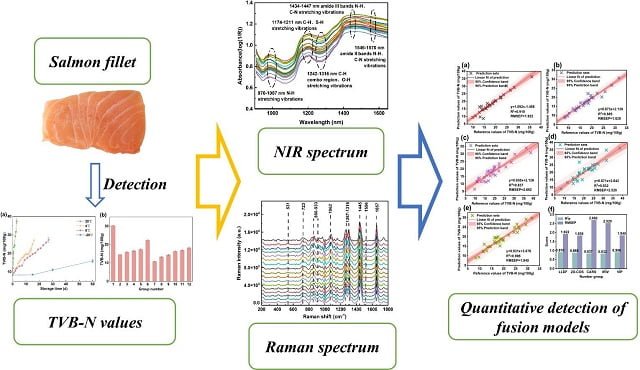
Have you ever wondered how fresh that salmon fillet you find in supermarket containers really is? Ensuring the freshness of salmon is crucial for both safety and flavor. However, traditional methods for measuring spoilage are destructive and time-consuming. Scientists are developing innovative methods to ensure that the highest quality fish is obtained.
A study published by scientists from the Ocean University of China and the Xinjiang Institute of Technology explored the potential of Raman spectroscopy and near-infrared (NIR) spectroscopy, combined with advanced data analysis, to accurately measure TVB-N (total volatile basic nitrogen) in salmon (Salmo salar). The researchers employed an intelligent approach called “data fusion” to combine information from NIR and Raman spectroscopy. This allowed them to create a more precise image of the internal chemistry of salmon.
Why is TVB-N important?
Freshness is a significant factor in meat quality, affecting both flavor and nutritional value. As storage time increases, meat freshness, including salmon, deteriorates. This deterioration is reflected in an increase in total volatile basic nitrogen (TVB-N).
Total volatile basic nitrogen (TVB-N) is a key indicator of seafood freshness. As fish decomposes, proteins break down into these nitrogenous compounds. By measuring TVB-N levels, we can determine the freshness and safety of fish for consumption.
Traditionally, measuring TVB-N involves complex procedures that destroy the sample. This new method offers a quick and non-destructive alternative.
Illuminating Freshness
The new study investigated the use of NIR and Raman spectroscopy (techniques that analyze the interaction of light with the sample) to detect TVB-N in salmon fillets stored at various temperatures. The researchers then employed a “data fusion” approach, combining information from NIR and Raman spectra to create a more comprehensive image.
Multiple Techniques, Improved Precision
The study compared different data fusion strategies:
- Low-Level Data Fusion (LLDF): This method directly fused the raw spectral data from NIR and Raman for analysis.
- Mid-Level Data Fusion (MLDF): Here, features extracted from each spectrum were combined before analysis.
The results were impressive. LLDF proved to be the most accurate approach, achieving a prediction model with an R² value (a measure of how well the model fits the data) of 0.910 and a low RMSEP (root mean square error of prediction) of 1.922 mg/100 g.
Benefits for Consumers and Beyond
Imagine a future where supermarkets can quickly and easily determine TVB-N levels, ensuring that consumers get the freshest fish possible. Additionally, this approach has the potential to be applied to other meat products, improving food safety and quality across the industry.
The new technology has the potential to revolutionize freshness assessment, resulting in several benefits:
- Greater Consumer Safety: By accurately detecting spoilage, supermarkets can ensure that only the freshest fish reaches consumers, minimizing the risk of foodborne illnesses.
- Improved Quality Control: Producers and distributors can gain valuable insights into storage and handling practices, optimizing the freshness of their salmon throughout the supply chain.
- Waste Reduction: Early detection of spoilage can help prevent perfectly good fish from being discarded, minimizing waste and maximizing profits.
Conclusion
The study highlights the potential of spectroscopy combined with data analysis for the rapid prediction of TVB-N values in salmon samples by integrating NIR and Raman spectral data.
“After comparing LLDF and MLDF strategies based on feature extraction techniques like 2D-COS, CARS, IRIV, and VIP, the results showed that LLDF and MLDF-VIP strategies exhibited good predictive performance with an R²P value above 0.900,” the researchers conclude.
As research advances, we can expect even more sophisticated methods to emerge, ensuring that the seafood we consume is not only delicious but also safe.
The study was funded by the National Natural Science Foundation of China, the Postdoctoral Research Foundation of China, the China Agriculture Research System of MOF and MARA, the Postdoctoral Innovation Project of Shandong Province, and the Qingdao Postdoctoral Applied Research Project.
Contact
Kaiqiang Wang
State Key Laboratory of Marine Food Processing & Safety Control, College of Food Science and Engineering, Ocean University of China
Qingdao, Shandong 266003, China
Email: wkq@ouc.edu.cn
Reference
Guo, M., Lin, H., Wang, K., Cao, L., & Sui, J. (2024). Data fusion of near-infrared and Raman spectroscopy: An innovative tool for non-destructive prediction of the TVB-N content of salmon samples. Food Research International, 189, 114564. https://doi.org/10.1016/j.foodres.2024.114564

